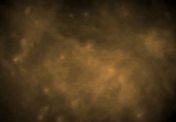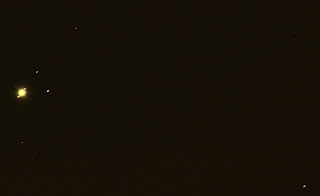April 29th 2140 GMT
I did a shoot of several objects with my DSLR. I used ISO 6400, 2 seconds exposure and 300mm focal length. I processed each set with Deep Sky Stacker.
I started off with Jupiter and its moons but had some focus problems. 7 out of 13 frames stacked.
Unfortunately, the other shots were out of focus.
April 29th 1800 GMT
The Sun was low and it was cloudy but I still managed to see the main sunspot.
April 28th 0745 GMT
I checked the Sun with my PST. It was rather quiet, apart from around the sunspot. There was also a small prominence and associated filament around the 5 o’clock position. I took some full disc and close-up shots.
I also checked the Sun in my binoculars.
The sunspot had rotated but I could not see anything else.
April 27th 1220 GMT
There was a clear patch of sky so I checked the Sun with my PST. In addition to the sunspot, I could see a prominence. I took some full disc shots and close-ups.
April 27th 0800 GMT
It was clear enough to do a shoot with my Mak and DSLR but I had a busy day at work ahead of me, so just did a bin scan. As expected, the sunspot had rotated.
April 26th 2145 GMT
There was quite a bit of cloud about but I did a night shoot anyway. It was a bit late, conditions weren’t great so I didn’t shoot any darks.
I shot 9 frames of Jupiter with moons ISO 6400, 300mm, 2 seconds. I stacked the seven that were in focus using Microsoft ICE.
I shot14 frames of M44 ISO 6400 300mm, 2 seconds of which I stacked 10. I was quite amazed at how well the shot turned out.
I shot 10 frames of the head of Draco ISO 6400 70mm, 10 seconds. Unfortunately, no frames stacked but a single frame showed Nu split into its two components.
April 26th 0935 GMT
I bin scanned the Sun in a patch of clear sky and saw the sunspot was just about as central as it could get.
April 25th 1110 GMT
I bin scanned the Sun through thin cloud and saw that the sunspot had rotated. To be honest, I wasn’t even expecting to get binoculars onto the Sun, as the weather forecast was poor.
April 24th 0935 GMT
I bin scanned the Sun through moving cloud and saw the sunspot that I had seen previously.
April 23rd 2355 GMT
Conditions were somewhat hazy, affecting even the Moon and Jupiter. I did some snaps with my DSLR at 300mm.
April 23rd 1030 GMT
I checked the Sun in hydrogen alpha light and white light. A sunspot was visible in white light.
April 20th 0720 GMT
I woke up to clear sky, so did a white light solar shoot followed by a hydrogen alpha one. Even through the Mak, the Sun looked bland and I could not see any sunspots in the camera viewfinder.
In hydrogen alpha light, the solar disc looked quite bland, except for the active area that was rotating off.
April 19th 2100 GMT
I rigged up my new Xbox cam with my Mak. I got a few imaging runs of the Moon but was unable to capture Jupiter. I was getting rather tired by the end, so I attached the DSLR instead and snapped our moon (full disc) and Jupiters'.
The Jupiter shots were out of focus.
April 19th 1655 GMT
I bin scanned the Sun in a clear sky. The large sunspot appeared to have rotated off. The small one, visible in the Big Bear images, was probably below the resolution of my binoculars. A blank disc!
April 17th 1800 GMT
With bad weather forecast for the evening, I took 32 frames of the full lunar disc. I was quite pleased with the result.
April 17th 1000 GMT
I did some white light full disc shots with my Mak and DSLR.
April 17th 0920 GMT
The sky was clear, so I went out with my PST and compact digital camera. The Sun was quiet, yet again, except for around the active region but some photos showed prominence activity.
I took some full disc shots and close-ups of the active region.
April 16th 2140 GMT
I did a shoot with the DSLT at 660mm on Jupiter, the Moon and Castor.
Only the Jupiter with moons shots produced any viable results.
April 14th 0835 GMT
The sunspot appeared not to have rotated much from the day before.
April 13th 0735 GMT
A solar bin scan suggested that the large sunspot had split.
April 12th 2100 GMT
I did some full disc shots of the Moon with my Mak and DSLR. I had trouble getting the exposure right. In the end I found ISO 400 and 1/200 second exposure worked. I stacked 38 frames.
April 12th 1330 GMT
I bin scanned the Sun through cloud and saw the large sunspot.
Apr 12th 1100 GMT
I checked the Sun with my DSLR but don't think I caught any sunspots. I checked the frames and thought they were somewhat out of focus.
April 11th 1610 GMT
Against all odds, the sky cleared enough for me to see the solar disc though the clouds. I could see the large sunspot through my binoculars and filters.
April 10th 0850 GMT
The sky was mostly clear, so I did a white light solar shoot. The sunspot had rotated further onto the solar disc and was showing more detail.
I then tried hydrogen alpha light, using my PST. I could not see anything apart from the sunspot, so just did some full disc shots and close-ups of the sunspot.
April 10th 2300 GMT
Yes, this happens! The date is day but the time is of the day before, due to daylight
savings adjustments. Anyway, the main point was that the sky was clear. So it was time for the DSLR at 300mm ISO6400 and 2 seconds exposure. I took 12 dark frames.
First up, Jupiter's moons. What else? I stacked 7 of 15 frames to get this result:
I took three regions of Auriga.
The first was 10 frames and showed some double stars.
I couldn't get the second region to stack so I processed a single frame.
The first was 10 frames and showed some double stars.
I couldn't get the second region to stack so I processed a single frame.
I finished with the Beehive (M44). Unfortunately, I could not get any decent frames.
April 9th 1700 GMT
April 9th 1700 GMT
There was an unexpected clear period. I took some full disc and close-ups of the active region before cloud rolled in again.
April 9th 0730 GMT
I checked the Sun in hydrogen alpha light. Visually, it seemed to add little to the white light view but I was hoping to find something in the photos.
April 9th 0710 GMT
I woke up to a clear sky and saw an amazing sunspot, with lots of activity in “white light” nearby. I used the Mak and DSLR.
April 8th 1600 GMT
Conditions continued to be difficult and haze affected the amount of light reaching my PST. I saw one small feature visually and the photo did not reveal much.
April 8th 0825 GMT
I bin scanned the Sun through thin cloud but did not see any sunspots.
April 7th 1600 GMT
I saw a rare patch of clear sky and bin scanned the Sun. Although I had seen some tiny sunspots in the Big Bear and Learmonth images, I did not see either of them.
April 6th 2040 GMT
It was dark but there was lots of moving cloud. I used my DSLR with 2 seconds’ exposure at 300mm and ISO6400.
I also took pot shots at Nu Draconi and Polaris, more in hope than expectancy.
Well, OK. I didn't get Nu Draconi but I did get 16 and 17, which look similar but are somewhat to the east and north.
I did get some of the stars surrounding Polaris.
Well, OK. I didn't get Nu Draconi but I did get 16 and 17, which look similar but are somewhat to the east and north.
I did get some of the stars surrounding Polaris.
April 3rd 1215 GMT
The weather was poor, as forecast but I still managed to see a sunspot through the cloud.
April 2nd 1100 GMT
I checked the Sun with my PST but it seemed quiet, apart from the sunspot.
One full disc shot showed a detached prominence.
Another full disc shot showed disc detail.
I managed to combine the two.
April 2nd 1040 GMT
A solar bin scan showed that the sunspot had rotated closer to the solar limb.
April 1st 0655 GMT
Most of the sky was cloudy but I managed to bin scan the Sun and saw that the sunspot had rotated.






























































































